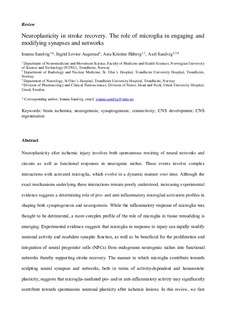Neuroplasticity in stroke recovery. The role of microglia in engaging and modifying synapses and networks
Journal article, Peer reviewed
Accepted version

Åpne
Permanent lenke
http://hdl.handle.net/11250/2589669Utgivelsesdato
2018Metadata
Vis full innførselSamlinger
Originalversjon
https://doi.org/10.1111/ejn.13959Sammendrag
Neuroplasticity after ischaemic injury involves both spontaneous rewiring of neural networks and circuits as well as functional responses in neurogenic niches. These events involve complex interactions with activated microglia, which evolve in a dynamic manner over time. Although the exact mechanisms underlying these interactions remain poorly understood, increasing experimental evidence suggests a determining role of pro‐ and anti‐inflammatory microglial activation profiles in shaping both synaptogenesis and neurogenesis. While the inflammatory response of microglia was thought to be detrimental, a more complex profile of the role of microglia in tissue remodelling is emerging. Experimental evidence suggests that microglia in response to injury can rapidly modify neuronal activity and modulate synaptic function, as well as be beneficial for the proliferation and integration of neural progenitor cells (NPCs) from endogenous neurogenic niches into functional networks thereby supporting stroke recovery. The manner in which microglia contribute towards sculpting neural synapses and networks, both in terms of activity‐dependent and homeostatic plasticity, suggests that microglia‐mediated pro‐ and/or anti‐inflammatory activity may significantly contribute towards spontaneous neuronal plasticity after ischaemic lesions. In this review, we first introduce some of the key cellular and molecular mechanisms underlying neuroplasticity in stroke and then proceed to discuss the crosstalk between microglia and endogenous neuroplasticity in response to brain ischaemia with special focus on the engagement of synapses and neural networks and their implications for grey matter integrity and function in stroke repair.